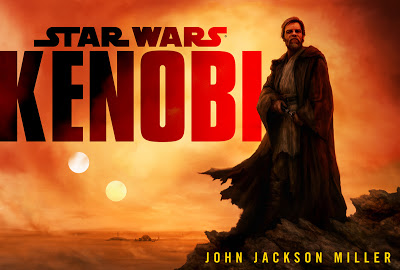If you’re regular listeners of the podcast, you already know that the Tosche Station staff greatly enjoyed Kenobi, the latest Star Wars novel by John Jackson Miller. This post isn’t a proper review, but I’ll get this out of the way: I loved the book. It is by far my favorite novel of the year, and exceeded my expectations with flying colors. Despite my enjoyment, however, one of its plot points bothered me–not because of what happened, but because of my assumptions prior to it. And I immediately knew I had to write a blog post about it.
THE REST OF THIS POST CONTAINS MAJOR SPOILERS FOR KENOBI. PROCEED AT YOUR OWN RISK, AND DON’T SAY I DIDN’T WARN YOU.
One of my favorite things about Kenobi is the diversity of the cast. Although the novel is named after Obi-Wan, I’d argue the main protagonist is actually Annileen, a human woman who owns the store Dannar’s Claim in the Pika Oasis. Regulars at her store include a Zeltron female, a Nikto female, a Rodian male, and a Mon Cal male. The daughters of Annileen and Orrin Gault also play sizeable roles in the plot.
From the beginning, the Tusken Raiders are characterized as the antagonists, with A’Yark as their leader. Although part of the novel is told from A’Yark’s point of view, the pronoun “he” or “she” is never used. I assumed this was a stylistic choice to show A’Yark’s alien nature, and I also assumed that A’Yark was male. There were reasons for this, of course: Tusken Raiders have very strict gender roles, with the males as the warriors, and the residents of the Oasis refer to A’Yark (aka Plug-eye) as “he”.
Then, a little over halfway through the book, Ben and Annileen confront A’Yark during a battle. They not only realize that she is a female, but also that the dead Tusken they’ve presented to her as a way to earn her good graces is, in fact, her son.
To be clear, I loved this twist. It made A’Yark a much more interesting character in my mind–not because female characters are inherently more interesting, but because a female Tusken warrior is an aberration. It made the character much more complicated, and marked the beginning of her transition from antagonist to protagonist. Learning about A’Yark’s past, and how she came into power, was absolutely fascinating. I won’t lie: the book was already interesting, but after I learned A’Yark was female, it became even more engaging.
But once I got over the brilliance of the twist, I grew a bit disturbed. I sat back and asked myself–why did I assume A’Yark was male?
I’m a feminist. I haven’t been shy about wanting more well-rounded female characters in Star Wars. Yet I automatically assumed the Tusken war leader was male. It’s not that I don’t think a female can fill such a role, but the possibility never even crossed my mind. Why? Is it a testament to Miller’s writing ability? Blindly believing the gender references used by other characters in the book? Reliance on long-held knowledge of Tusken Raiders? Or, is it something more? Do I assume the worst about diversity because we’ve been clamoring for more well-rounded main protagonists for ages, or is it something else inherent in my mindset?
I don’t know the answers to those questions. I don’t know if I ever will. But it’s something I’ve been thinking about a lot lately, as the question of diversity in Star Wars has once again garnered attention. There are people who claim that Star Wars isn’t meant to be a progressive series, and bemoan the focus on so-called political correctness. They point to characters like Leia, Lando, Padme, Mace, Yoda, etc, as evidence that Star Wars is already diverse. I argue that one main female character or person of color or alien per trilogy is a good start, but we should always strive for greater diversity. We can always do better.
And, despite all this, I still assumed A’Yark was male.



I also automatically assumed A’Yark was male and I actually had to close the book when it was revealed to scold myself for that assumption.
I’m glad I’m not the only one!
I think it’s understandable when Tuskens have already been established as a male-dominant culture–to the point of the women even wearing different robes. JJM going against established canon to demonstrate the direness of the tribe’s situation is totally different from having a random female character who just happens to be a warrior of some sort.
Think of it like this–is he’d pulled the same trick with a Mandalorian, would you still have been that surprised?
*if he’d pulled
You’re assuming I’d read a book featuring a Mandalorian.
All kidding aside, you’re right that the previously-established gender roles played a huge part in this twist being possible. It was just one of those moments where I had to take a step back and wonder about my assumptions.
Pingback: Why Do We Write The Things We Do? « fangirlblog.com
The whole book is like that, outlining the pedestrian and subverting it. Civilized white folk kill nasty tribal monsters. The woman given most focus will end up with the male hero. Only one main female character per story. Then it twists it. The civilized white folk are the real monsters. The woman leaves on her own because ultimately the hero is as bad for her as the villain. And characters we assume are male are not. None of these points are that surprising in retrospect. Star Wars is a series that doesn’t care about women, so much of hollywood doesn’t and as a man so often assumed to be a woman the idea is not a new one to me.